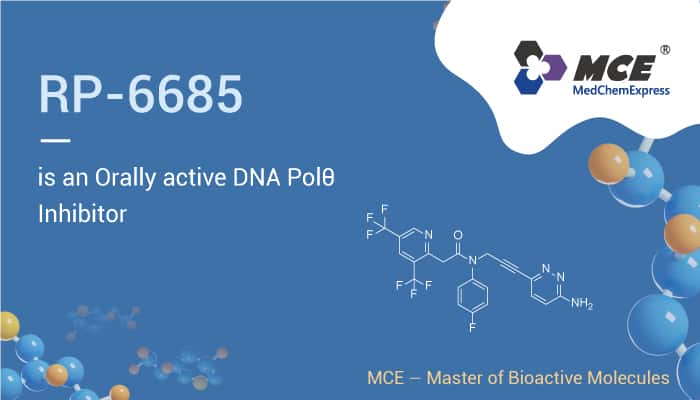DNA polymerase theta (Polθ) is a unique, large (290 kDa) multifunctional A-family DNA polymerase that is required for DNA double-strand breaks (DSBs) repair through the microhomology-mediated end-joining (MMEJ) pathway. Importantly, MMEJ is intrinsically mutagenic, whereas break sites are often scarred with insertions and deletions. Besides, increasing evidence suggests that MMEJ is uniquely important for DNA repair during mitosis.
Polθ promotes RNA-templated DNA repair. Besides, Polθ is an attractive synthetic lethal target for drug discovery, predicted to be efficacious against breast and ovarian cancers harboring BRCA-mutant alleles. Moreover, Loss of Polθ is synthetic lethal in tumor cells with impaired DNA repair resulting from multiple genetic alterations. Here, we describe a selective inhibitor of human Polθ (encoded by POLQ).
RP-6685 is an orally active DNA Polθ inhibitor.

RP-6685 is a potent, selective and orally bioavailable Polθ inhibitor with an IC50 value of 5.8 nM. Particularly, the Knockdown of Polθ or knock-in of polymerase-dead Polθ results in the ablation of MMEJ with a corresponding increase in NHEJ-mediated repair. While RP-6685 (0-1 µM) is extremely potent with an IC50 of 550 pM against the pol activity of full-length Polθ and inactive on the ATPase activity. Specifically, RP-6685 (10-10 000 µM) inhibits Alt-EJ-mediated DNA repair in a dose-dependent manner. Moreover, RP-6685 inhibits the proliferation of HCT116 BRCA2-/- cells.
RP-6685 shows a favorable PK profile with good oral bioavailability in mice. Specifically, RP-6685 (80 mg/kg; p.o.; 21 days) inhibits the tumor growth during the first 8 days of treatment in BRCA2-/- HCT116 model, while does not inhibit tumor growth in BRCA2+/+ HCT116 tumors mice. Meanwhile, RP-6685 (2.5 mg/kg; i.v. or p.o.; single dosage) also shows good oral bioavailability in CD1 mice, with t1/2 of 0.4 h and F of 66%。
All in all, RP-6685 is a potent, selective, and orally active DNA Polθ inhibitor with antitumor efficacy.
Reference:
[1] Bubenik M, et al. J Med Chem. 2022 Oct 13;65(19):13198-13215.